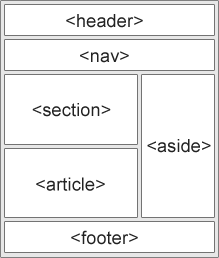HTML5 Semantic Elements
Semantic = Meaning.
Semantic elements = Elements with meaning.
What are Semantic Elements?
A semantic element clearly describes its meaning to both the browser and the developer.
Examples of non-semantic elements: <div> and <span> – Tells nothing about its content.
Examples of semantic elements: <form>, <table>, and <img> – Clearly defines its content.
Browser Support
Internet Explorer 9+, Firefox, Chrome, Safari and Opera supports the semantic elements described in this chapter.
Note: Internet Explorer 8 and earlier does not support these elements. However, there is a solution.
New Semantic Elements in HTML5
Many of existing web sites today contains HTML code like this: <div id=”nav”>, <div>, or <div id=”footer”>, to indicate navigation links, header, and footer.
HTML5 offers new semantic elements to clearly define different parts of a web page:
- <header>
- <nav>
- <section>
- <article>
- <aside>
- <figure>
- <figcaption>
- <footer>
- <details>
- <summary>
- <mark>
- <time>

HTML5 <section> Element
The <section> element defines a section in a document.
According to W3C’s HTML5 documentation: “A section is a thematic grouping of content, typically with a heading.”
Example
<h1>WWF</h1>
<p>The World Wide Fund for Nature (WWF) is….</p>
</section>
HTML5 <article> Element
The <article> element specifies independent, self-contained content.
An article should make sense on its own and it should be possible to distribute it independently from the rest of the web site.
Examples of where an <article> element can be used:
- Forum post
- Blog post
- News story
- Comment
Example
<h1>Internet Explorer 9</h1>
<p>Windows Internet Explorer 9 (abbreviated as IE9) was released to
the public on March 14, 2011 at 21:00 PDT…..</p>
</article>
HTML5 <nav> Element
The <nav> element defines a set of navigation links.
The <nav> element is intended for large blocks of navigation links. However, not all links in a document should be inside a <nav> element!
Example
<a href=”/html/”>HTML</a> |
<a href=”/css/”>CSS</a> |
<a href=”/js/”>JavaScript</a> |
<a href=”/jquery/”>jQuery</a>
</nav>
HTML5 <aside> Element
The <aside> element defines some content aside from the content it is placed in (like a sidebar).
The aside content should be related to the surrounding content.
Example
<h4>Epcot Center</h4>
<p>The Epcot Center is a theme park in Disney World, Florida.</p>
</aside>
HTML5 <header> Element
The <header> element specifies a header for a document or section.
The <header> element should be used as a container for introductory content.
You can have several <header> elements in one document.
The following example defines a header for an article:
Example
<header>
<h1>Internet Explorer 9</h1>
<p><time pubdate datetime=”2011-03-15″></time></p>
</header>
<p>Windows Internet Explorer 9 (abbreviated as IE9) was released to
the public on March 14, 2011 at 21:00 PDT…..</p>
</article>
HTML5 <footer> Element
The <footer> element specifies a footer for a document or section.
A <footer> element should contain information about its containing element.
A footer typically contains the author of the document, copyright information, links to terms of use, contact information, etc.
You can have several <footer> elements in one document.
Example
<p>Posted by: Hege Refsnes</p>
<p><time pubdate datetime=”2012-03-01″></time></p>
</footer>
HTML5 <figure> and <figcaption> Elements
The <figure> tag specifies self-contained content, like illustrations, diagrams, photos, code listings, etc.
While the content of the <figure> element is related to the main flow, its position is independent of the main flow, and if removed it should not affect the flow of the document.
The <figcaption> tag defines a caption for a <figure> element.
The <figcaption> element can be placed as the first or last child of the <figure> element.
Example
<img src=”img_pulpit.jpg” alt=”The Pulpit Rock” width=”304″ height=”228″>
<figcaption>Fig1. – The Pulpit Pock, Norway.</figcaption>
</figure>
Can We Start Using These Semantic Elements?
The elements explained above are all block elements (except <figcaption>).
To get these elements to work properly in older browsers, set the display property to block in your style sheet (this causes older browsers to render these elements correctly):
{
display: block;
}
Problem With Internet Explorer 8 And Earlier
IE8 and earlier does not know how to render CSS on elements that it doesn’t recognize. You cannot style new HTML5 elements like <header>, <section>, <footer>, <aside>, <nav>, <article>, <figure>.
Thankfully, Sjoerd Visscher has discovered a JavaScript workaround called HTML5 Shiv; to enable styling of HTML5 elements in versions of Internet Explorer prior to version 9.
You can download and read more about the HTML5 Shiv at: http://code.google.com/p/html5shiv/
To enable the HTML5 Shiv (after downloading), insert the following code into the <head> element:
<script src=”html5shiv.js”></script>
<![endif]–>
The code above is a comment that only versions earlier than IE9 reads. It must be placed in the <head> element because Internet Explorer needs to know about the elements before it renders them.
Semantic Elements in HTML5
Below is an alphabetical list of the new semantic elements in HTML5. The links goes to our complete HTML4/5 tag reference.
| Tag | Description |
|---|---|
| <article> | Defines an article |
| <aside> | Defines content aside from the page content |
| <details> | Defines additional details that the user can view or hide |
| <figcaption> | Defines a caption for a <figure> element |
| <figure> | Specifies self-contained content, like illustrations, diagrams, photos, code listings, etc. |
| <footer> | Defines a footer for a document or section |
| <header> | Specifies a header for a document or section |
| <mark> | Defines marked/highlighted text |
| <nav> | Defines navigation links |
| <section> | Defines a section in a document |
| <summary> | Defines a visible heading for a <details> element |
| <time> | Defines a date/time |
11,611 total views, 1 views today